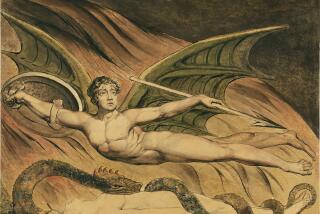Frederick Evans photos at the Getty
- Share via
Four or five images come to mind upon mention of the British photographer Frederick Evans: his transcendent view up a staircase in Wells Cathedral (the famous “Sea of Steps”); luminous pictures of the attic at Kelmscott Manor, home of the British Arts and Crafts movement leader William Morris; incisive portraits of a young Aubrey Beardsley and a costumed F. Holland Day.
More certainly ensconce themselves in the memory after a visit to the Getty Museum’s comprehensive Evans exhibition, but few penetrate the soul as deeply as those long-acclaimed greatest hits.
Evans had an impeccable instinct for form. His platinum prints -- whether portraits, landscapes or studies of architecture -- are pristine, tonally rich and consistently beautiful. Yet Evans valued information at least as much as inspiration (the show’s slightly stiff title, “A Record of Emotion,” perhaps alludes to this). He favored respectful distance over raw intimacy. When he did venture into that most personal terrain -- pure encounter with place, person or the spiritual self -- he produced some of the most profoundly moving photographs in the history of the medium.
Evans (1853-1943) worked initially as a bookkeeper and clerk and was running a London bookshop when he acquired his first camera. His earliest images were photomicrographs revealing exquisitely detailed patterns of insects and sea life. A sectional view of a sea urchin (magnified 40 times) could pass for an intricately crocheted doily.
He photographed fellow artists and friends he made through the bookshop, including George Bernard Shaw, who publicly championed Evans’ photographic work. Evans’ profile portrait of Beardsley (whose career as an illustrator Evans helped launch) is a gem, the long upward line of the artist’s fingers, supporting his chin, answered by the cool downward gaze of his eyes.
Evans also made lovely, pleasant, if not very distinctive photographs of the British countryside. What dominates the show (curated by the Getty’s Anne Lyden) and Evans’ canonical reputation are his pictures of medieval cathedrals. From the 1880s until the 1910s, he visited the great religious edifices of England (and a few in France), spending weeks at a time at each location, studying the movement of light within. He made what amounted to extended portraits of the churches, combining long exterior views to establish context with multiple interior perspectives and details of architectural ornamentation. The vacant, light-soaked spaces relate to those in 17th century Dutch church paintings as well as to J.M.W. Turner’s delicate watercolors of cathedrals, which Evans admired.
The work comprises a tremendous historical archive, not only of grand material structures but of the sensation of occupying them, the palpable atmosphere of awe and respect. Frequently, Evans would position himself in a shadowed aisle and shoot toward the more brightly illuminated nave, articulating a physical passage (sometimes zigzagging or curved) from dark to light that paralleled the spiritual journeys taking place within.
When he scaled down from vast public areas to picture smaller, more private zones of a cathedral, that feeling of individual reckoning grows profound. The most iconic example is his 1903 “A Sea of Steps, Wells Cathedral.” Looking up across an undulating wave of worn stone stairs to the bright passageway at its crest, Evans frames an eloquent metaphor of pilgrimage and ascent.
His 1896 photograph of the attic of Kelmscott Manor has much the same power and sense of holiness despite its secular, domestic setting. Humble counterparts to the ribs of cathedrals’ arched vaults, the wooden beams of the attic’s pitched roof invoke both shelter and aspiration, safety and promise. The intimate attic space, suffused with light, beckons the eye -- and the soul -- forward.
What also makes many of Evans’ cathedral interiors so stirring is the way they manifest his fascination with patterns found in nature: spirals, symmetries, curves and repetitions. He pursued those phenomena early on in his photomicrographs and replicated them as well in ink drawings made with a pendulum device called a Harmonograph. Only one such drawing appears in the show, but its elaborate, mathematically precise unfurling resonates acutely with Evans’ emphasis on the rhythms and patterns of spiral staircases and receding colonnades.
His focus on medieval church architecture’s echoes of nature’s inherent order and beauty was likely his Swedenborgian way of attesting to a fundamental divinity uniting spiritual and physical realms.
Evans was a perfectionist and a purist (disavowing manipulation of photographic negative or print). Truth mattered to him, and as he pictured it, the truth of the world, given and built, was nothing but perfect and pure.
More to Read
The biggest entertainment stories
Get our big stories about Hollywood, film, television, music, arts, culture and more right in your inbox as soon as they publish.
You may occasionally receive promotional content from the Los Angeles Times.










